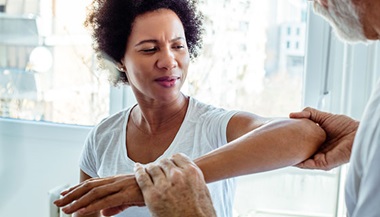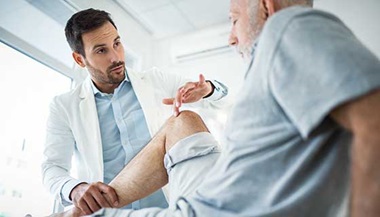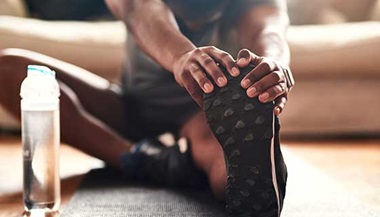Female Athletes: Common Sports Injuries and Prevention
Featured Expert
Sports participation comes with a host of mental and physical benefits, for people of all genders. But it comes with some risks, too. Women and girls have risk factors that can make them more likely than male athletes to experience certain injuries or health problems.
Women’s sports medicine expert Alexis Coslick, D.O., discusses these risks and the steps female athletes can take to stay healthy and perform at their best levels.
Sports Injury Risk Factors in Female Athletes: The Role of Anatomy
Women and girls are powerful athletes. But they may be more likely to experience certain sports injuries because of their anatomy and hormones. Female athletes and athletes assigned female at birth tend to be shorter and lighter compared to male athletes. They are also more likely to have certain anatomical features:
- Narrow shoulders: This can result in less upper body strength. With less strength in the arms and shoulders, athletes may compensate in ways that increase the risk of injuring other areas, like the back.
- Wide hips: Broader hips create an angle between the hips and knees that puts stress on knee joints.
- Weak core: Strong back and abdominal muscles stabilize the body and help absorb force when running or jumping. A weak core can lead to injuries in the hips, knees and ankles.
- Short limbs: People with shorter legs and arms must use more force to achieve the same results as people with longer extremities when running, jumping or throwing.
- Increased joint laxity (hypermobility): After puberty, women’s joints tend to have a greater range of motion than those of men. This increases the risk of ligament injuries such as ankle sprains or anterior cruciate ligament (ACL) tears.
- Strong quadriceps muscles with weak hamstrings: This combination causes an imbalance that can strain the knee and increase the odds of knee injuries.
- Small head and neck: A smaller head means less ability to absorb shock. Research suggests that smaller head size and neck girth might be one reason that concussions are more common in female athletes than male athletes. Concussion symptoms also tend to last longer in women.
Many of these features affect an athlete’s biomechanics — the physics of how the body moves. If an athlete has weak hamstrings and flexible joints, for example, she’s more likely to twist at the knee when landing from a jump. A good training and conditioning program can help athletes improve their biomechanics.
The Role of Hormones in Female Athletes
Hormones also can influence women’s sports injury risk.
In adolescence, girls undergo the hormonal changes of puberty. Those hormones trigger the start of monthly periods and other physical changes, like growth spurts. Sudden changes in height can affect an athlete’s biomechanics, putting them at risk of injury. Hormonal changes can also affect the joints and muscles directly. Before puberty, for example, boys and girls have a similar risk of ligament injuries such as ACL tears. After puberty, women develop greater joint laxity, significantly increasing their risk of ligament injuries compared to male athletes.
Even after puberty, hormones affect athletes in ways they might not realize. Hormone levels rise and fall throughout the menstrual cycle. Research shows those variations can affect things like joint flexibility, strength, body temperature and neuromuscular control. Those frequent changes can make it more likely for women to suffer a sports injury.
Hormones also factor into two important phenomena: the female athlete triad and relative energy deficiency in sports (REDs).
What is the female athlete triad?
The female athlete triad is a group of three conditions that go hand in hand.
- Low energy intake: This occurs when athletes do not take in enough calories to fuel their exercise. Sometimes, that happens as a result of disordered or picky eating or pressure to be thin. But it can also happen when athletes do not have a good understanding of the nutrition they need. That includes getting enough calories, adequate protein, and nutrients such as calcium and vitamin D for strong bones.
- Menstrual dysfunction: Low energy intake can lead to hormonal changes that cause irregular periods. Some athletes stop having periods completely. Unfortunately, many people believe losing your period is a normal part of elite athletics. “An irregular or absent period is not normal. It is a warning sign,” says Coslick. “Girls and women should be having regular periods, even when they are training hard.”
- Low bone mineral density: Low energy availability and hormonal changes can affect bone strength. In the short term, that puts female athletes at risk of sports injuries such as stress fractures. It also sets them up for future problems. “Peak bone mass is achieved by age 30, but maximal bone building occurs by 18, which makes meeting adequate energy needs so essential in the adolescent years,” says Coslick. After age 30, bone loss starts, so it is important to reach the highest possible maximum. Young athletes who are not building bone may be at greater risk of developing osteoporosis.
What is REDs?
Researchers have recognized the female athlete triad for some time. More recently, they’ve come to realize that the triad is part of a larger syndrome known as REDs, which stands for relative energy deficiency in sports.
Low energy intake from poor nutrition affects systems throughout the body, and it can affect any athlete. In female athletes, along with menstrual dysfunction and low bone density, REDs can cause problems with:
- The heart and blood circulation
- The gastrointestinal system
- Growth and development
- Hormone function
- Immune function
- Mental health
- Metabolism
REDs can interfere with both health and sports performance in many ways. Some of those consequences include:
- Decreased muscle strength and endurance
- Decreased training response
- Impaired judgment
- Increased injury risk
- Irritability and depression
- Poor concentration
- Reduced coordination
- Reduced energy stores
Athletes who are diagnosed with female athlete triad or REDs should restrict physical activity and increase their energy intake until they recover. “It is so important to take these symptoms seriously,” says Coslick. “Overcoming this energy deficiency is critical for both sports performance and long-term health.”
Common Sports Injuries in Female Athletes
As a result of women’s unique anatomy and hormones, they are at an elevated risk of certain sports injuries. The injuries most common in female athletes include:
- Knee injuries
- ACL injuries, especially those that are not caused by contact with another athlete
- Patellofemoral pain syndrome (runner’s knee)
- Patellar tendonitis (jumper’s knee)
- Shoulder injuries such as rotator cuff injury
- Plantar fasciitis
- Stress fractures
- Ankle sprains
- Concussions
The Johns Hopkins Women’s Sports Medicine Program

The Women’s Sports Medicine Program at Johns Hopkins features experts in nutrition, concussions, orthopaedic surgery, physical therapy and more. Our team understands the unique needs of female athletes and uses a “whole body” approach to treatment.
Preventing Sports Injuries: Tips for Female Athletes
While women’s anatomy and other factors can increase their risk of some sport injuries, getting hurt is not inevitable. There are many actions that women, girls, their coaches and support team can take to prevent sports injuries.
Exercise smarter
Do not focus only on movements unique to your sport. Cross training — performing a variety of different types of exercises — can help improve strength, balance and flexibility. That, in turn, can reduce the risk of injury.
Try to develop a routine that includes activities such as:
- Activities that improve flexibility, such as yoga or pilates
- Aerobic exercises, such as running or biking, to improve cardiovascular health
- Exercises designed to improve balance, such as activities performed while shifting weight onto one leg or standing on a wobble board
- Strength training, including exercises that target the hamstring, quadriceps, hips, core, neck and back
Female athletes can also benefit from a neuromuscular training program. Such programs focus on exercises that aim to improve muscle strength, movement control, agility and reaction. Research shows that neuromuscular training performed under proper guidance can help reduce the risk of certain injuries and even boost athletic performance.
Focus on technique
Learning proper form and technique can go a long way toward injury prevention. Female athletes should work with coaches and athletic trainers to develop proper techniques for their sport, such as landing correctly after a jump, establishing an optimal running gait or developing correct throwing or swinging motions of the arm.
Manage exercise intensity and frequency
Training hard can yield good results. But there is such a thing as training too hard or too much. Athletes should work closely with coaches, athletic trainers, physical therapists or sports medicine doctors to determine how much and how intensely to train. These guidelines will depend on the athlete’s age, health, skill level, performance goals and other factors.
Managing your exercise load means having a plan for the number of sessions you perform each day and each week and how hard you push yourself. It is also important to balance your workload across your body. Aim to develop upper- and lower-body strength and exercise both sides of the body equally.
Schedule rest
Rest days are not a sign of laziness. The body needs down time to refuel and repair damaged tissues. Rest also gives athletes a mental break so they can perform at their best when they return to play.
The American Council on Exercise (ACE) recommends alternating high-intensity workouts with low- or moderate-intensity sessions. ACE also recommends taking a day of complete rest at least once every 7-10 days.
Longer breaks from sport can also be beneficial, especially for younger athletes who are still developing physically and psychologically. The American Academy of Pediatrics recommends that children take at least one to two days off a week from competition and sport-specific training, as well as spend two to three months a year away from a specific sport.
Nutrition for female athletes
Good nutrition is critical for athletes. To perform at their best and prevent injury, female athletes need to ensure they are eating enough calories to fuel their activity.
Focus on important nutrients such as protein, iron, calcium and vitamin D. Iron-deficiency anemia is common in women, who are at greater risk in part because of menstruation. It may be even more common in athletes. One study found nearly half of highly trained female athletes had lower iron levels than they should, which can affect athletic performance and impair overall health.
Women who are not on a vegetarian diet and who have periods should consume 18 milligrams of iron daily. Red meat is the best source of iron. People who do not eat red meat may need a supplement, and should discuss their iron levels with their doctor.
Protein is important, too. The American College of Sports Medicine recommends that female athletes consume 1.2-2 grams of protein per kilogram (2.2 pounds) of body weight each day. In other words, a woman who weighs 150 pounds should get about 81-136 grams, or 2.8-4.8 ounces, of protein per day.
Sports medicine doctors and nutritionists can help athletes develop healthy eating plans to make sure they get the nutrients they need.
BMI for female athletes
Many athletes — and even some coaches — believe that a thin body is a healthy one. They often use body mass index (BMI) as an indicator of healthy weight. However, BMI is not always a good measure of health for athletes.
According to the U.S. Centers for Disease Control and Prevention, a BMI over 25 is considered overweight, and a BMI over 30 is considered obese. But because athletes usually have more muscle mass and less body fat than the average person, they tend to have a higher BMI. That means they may be very fit and healthy, even if their BMI is greater than 25.
Rather than relying on BMI as an indicator of health, athletes should discuss with their doctor what a healthy weight looks like for them.
What to do if you get injured
If you experience pain or discomfort, that is your body’s way of telling you something is wrong. Consider it a sign to seek care.
Several types of health-care professionals can treat sports injuries, including:
- Primary care sports medicine physicians: These doctors treat the whole body, just like a regular primary care doctor. But they also have specialized training in sports medicine. They are a great first line of care for diagnosing and treating most acute and chronic sports injuries, including sprains, strains and overuse injuries. They can also perform joint injections, help screen for and manage concussions, as well as work with physical therapists on a return-to-sport plan.
- Sports medicine surgeons: These are orthopaedic surgeons with specialized training and expertise in sports-related injuries. Their focus is the surgical repair of injuries such as ACL tears or rotator cuff tears.
- Physical and occupational therapists: These specialists create targeted exercise plans to treat sports injuries, prepare patients for surgeries, help patients recover after surgeries and help prevent injuries in the future.
- Concussion specialists: Doctors from many specialties work together to diagnose and treat people with concussions. These can include physical medicine and rehabilitation physicians, neurologists and neuropsychologists.
Whether you are dealing with an overuse injury like runner’s knee, or a traumatic injury like an ACL tear, your sports medicine team will put you on a path to healing. “It can be really hard for an athlete to be sidelined with injuries,” says Coslick. “But taking care of your body and working with your care team will help you get back in the game.”







